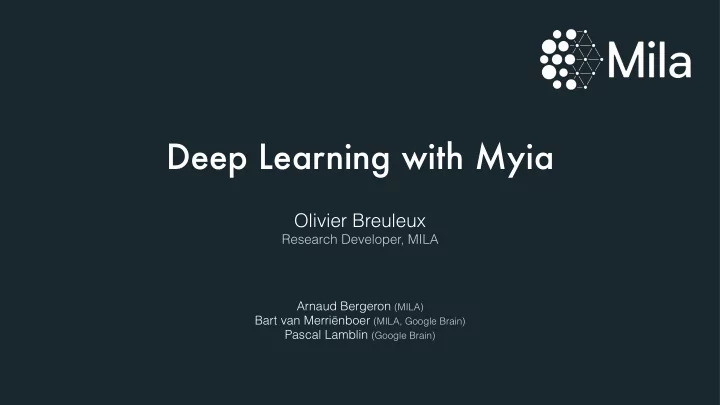

Deep Learning with Myia Olivier Breuleux Research Developer, MILA Arnaud Bergeron (MILA) Bart van Merriënboer (MILA, Google Brain) Pascal Lamblin (Google Brain)
The Needs What we need from a language for deep learning Autodiff What it is, how it works, what the challenges are Representation The best representation for our needs Type system Flexible inference for performance and robustness 2
The Needs What we need from a language for deep learning Autodiff What it is, how it works, what the challenges are Representation The best representation for our needs Type system Flexible inference for performance and robustness 3
Deep Learning DL algorithms are increasingly complex …? Feedforward Recurrent Recursive (trivial) (loops) (recursion) 4
Deep Learning DL algorithms are increasingly complex More and more language features needed • Most existing frameworks are limited • High level abstraction increases productivity • • Focus on the algorithm over implementation details Effortless abstractions encourage their use • 5
Needs Goal: a language adapted to the needs of machine learning, past and future General purpose: Capable of expressing complex control flow. Differentiable: Should be able to take nth-order derivative of any program. Debuggable: Clear errors, inspectable, instrumentable. Fast: Must leverage parallelism and GPU. Portable: Serializable, support multiple hardware. 6
Needs Myia: a language adapted to the needs of machine learning, past and future General purpose: Conditionals, loops, recursion, data structures. Differentiable: Transformation at the intermediate representation level. Debuggable: Type+shape inference, step debugger. Fast & portable: Choose from various backends such as NNVM/Relay. 7
The Needs What we need from a language for deep learning Autodiff What it is, how it works, what the challenges are Representation The best representation for our needs Type system Flexible inference for performance and robustness 8
Differentiability How to train a model Initialize a model’s parameters θ • Compute some quantity using the parameters f ( x ; θ ) • Compute a cost or “loss function” L ( f ( x ; θ ), y ) • Update parameters using the gradient of the loss • θ ← θ − λ ∂ L ( f ( x ; θ ), y ) Rinse and repeat • ∂ θ Gradients Can be computed exactly and automatically • But: no mainstream language supports this natively • Computational strategies : forward or reverse • Implementation strategies : operator overloading or source transform • 9
Recommend
More recommend